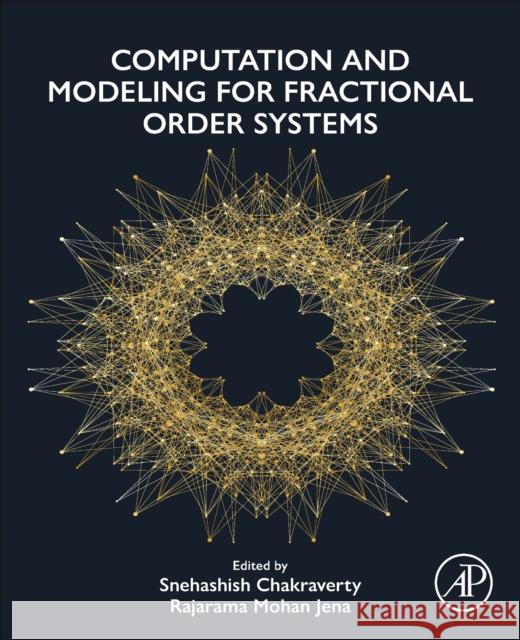Computation and Modeling for Fractional Order Systems » książka



Computation and Modeling for Fractional Order Systems
ISBN-13: 9780443154041 / Angielski
Computation and Modeling for Fractional Order Systems
ISBN-13: 9780443154041 / Angielski
(netto: 664,68 VAT: 5%)
Najniższa cena z 30 dni: 695,16 zł
ok. 18-20 dni roboczych.
Darmowa dostawa!
Chapter 1: Computational Efficient Analytical and Numerical Methods for Fractional Order Models - Hamid M. Sedighi - H-index 33 - Shahid Chamran University, Ahvaz, Iran
1.1. Introduction
1.2. Preliminaries
1.3. Analytical methods
1.4. Numerical Methods
1.5. Semi-analytical methods
1.6. Few examples
1.7. Conclusion
Chapter 2: Local Fractional Derivatives and Their Applications - Mehmet Yavuz - H-index 21 - University of Exeter, Cornwall UK
2.1. Introduction/Motivation
2.2. Concept of Local fractional derivatives
2.3. Mathematical Examples
2.4. Application problems
2.5. Conclusion
Chapter 3: Variable Order Fractal-Fractional Models - Thabet Abdeljawad - H-index 50 - Prince Sultan University, Riyadh, Saudi Arabia
3.1. Introduction
3.2. Variable order fractal-fractional derivatives
3.3. Variable order fractal-fractional integrals
3.4. Model description
3.5. Numerical algorithm
3.6. Example problems
3.7. Conclusion
Chapter 4: Piecewise Concept in Fractional Models - Waleed Adel - H-index 6 - Université Française d'Egypte and Rajarama Mohan Jena - H-index 13 - National Institute of Technology - Rourkela, India
4.1. Introduction
4.2. Piecewise derivative with global and classical types
4.3. Piecewise integral with global and classical types
4.4. Piecewise derivative with fractional derivatives
4.5. Piecewise derivative and integrals with singular and non-singular kernels
4.6. Numerical algorithms
4.7. Illustrative examples
4.8. Conclusion
Chapter 5: Fractional Order Integrodifferential Models - Snehashish Chakraverty - H-index 32 - National Institute of Technology, Rourkela, India and Nihar Ranjan Mallick - H-index 0 - National Institute of Technology, Rourkela, India (co-author is a graduate assistant to Dr. Chakraverty)
5.1. Introduction
5.2. Integrodifferential equations
5.3. Integrodifferential equations of fractional order
5.4. Numerical methods
5.5. Convergence analysis
5.6. Numerical examples
5.7. Conclusion
Chapter 6: Uncertainty Modelling and AI in Fractional Models - Snehashish Chakraverty - H-index 32 - National Institute of Technology, Rourkela, India, Kasimala Narasimha Rao, and Arup K. Sahoo - H-index 0 - National Institute of Technology, Rourkela, India (co-authors are graduate assistants to Dr. Chakraverty)
6.1. Introduction
6.2. Preliminaries of uncertainty and AI
6.3. Fractional models in uncertain environment
6.4. Machine Intelligence in fractional models
6.5. Numerical results
6.6. Conclusion
Chapter 7: Fractional Calculus in Epidemiology, Biomathematics, and Financial Mathematics - Sunday O. Edeki - H-index 16 - Covenant University - Ota, Nigeria
7.1. Introduction
7.2. Formulation of dynamical models related to the said title
7.3. Existence and uniqueness of the solution
7.4. Stability analysis
7.5. Numerical method
7.6. Error analysis
7.7. Result and discussion
7.8. Conclusion
Chapter 8: Nonlinear Dynamics and Chaos in Science and Engineering - Shengda Zeng - H-index - 22 - Uniwersytet Jagiellonski, Krakow, Poland
8.1. Introduction
8.2. Formulation of the model
8.3. Existence and uniqueness
8.4. Stability analysis
8.5. Chaotic study
8.6. Numerical method
8.7. Result and discussion
8.8. Conclusion
Chapter 9: Discrete Fractional Operators with Applications - Hadi Rezazadeh - H-index 38 - Amol University of Special Modern Technologies, Amol, Iran
9.1. Introduction
9.2. Concept of discrete fractional operators
9.3. Model formulation
9.4. Numerical method
9.5. Result and discussion
9.6. Conclusion
Chapter 10: New Fractional Operators in Real-Life Dynamical Models - Dumitru Baleanu - H-index 94 - Cankaya Universitesi, Ankara, Turkey
10.1. Motivation of using new fractional operators
10.2. Preliminaries
10.3. Description of real-life dynamical model
10.4. Existence and uniqueness
10.5. Stability analysis
10.6. Numerical algorithm
10.7. Result and discussion
10.8. Conclusion
Chapter 11: Application of Fractional Calculus in Electrical, Chemical, and Mechanical Engineering - Snehashish Chakraverty - H-index 32 - National Institute of Technology, Rourkela, India and Shweta Dubey - H-index 0 - National Institute of Technology, Rourkela, India (co-author is a graduate assistant to Dr. Chakraverty)
11.1. Introduction
11.2. Description of fractional models arise in electrical, chemical and mechanical engineering
11.3. Method description
11.4. Existence, uniqueness, and stability analysis
11.5. Result and discussion
11.6. Conclusion
1997-2025 DolnySlask.com Agencja Internetowa
KrainaKsiazek.PL - Księgarnia Internetowa









